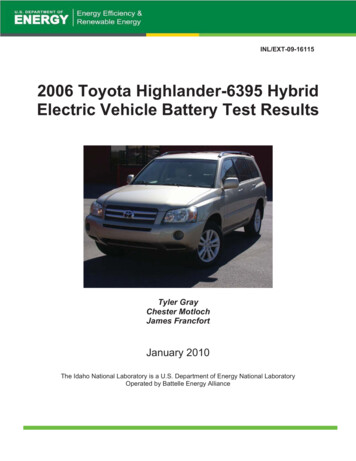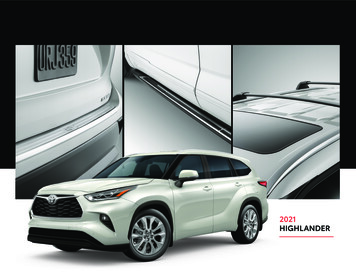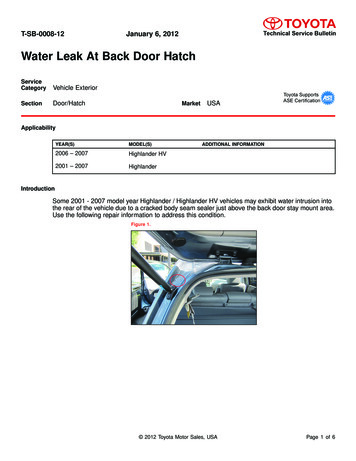
Transcription
INL/EXT-09-161152006 Toyota Highlander-6395 HybridElectric Vehicle Battery Test ResultsTyler GrayChester MotlochJames FrancfortJanuary 2010The Idaho National Laboratory is a U.S. Department of Energy National LaboratoryOperated by Battelle Energy Alliance
INL/EXT-09-161152006 Toyota Highlander-6395Hybrid Electric Vehicle Battery Test ResultsTyler Gray1Chester Motloch1James Francfort2January 2010Prepared for theU.S. Department of EnergyAssistant Secretary for Energy Efficiency and Renewable EnergyUnder DOE Idaho Operations OfficeContract DE-AC07-05ID145171 Electric Transportation Engineering Corporation2 Idaho National Laboratory
DisclaimersThis document highlights work sponsored by agencies of the U.S. Government. Neither theU.S. Government nor any agency thereof, nor any of its employees, makes any warranty, expressor implied, or assumes any legal liability or responsibility for the accuracy, completeness, orusefulness of any information, apparatus, product, or process disclosed, or represents that its usewould not infringe privately owned rights. Reference herein to any specific commercial product,process, or service by trade name, trademark, manufacturer, or otherwise does not necessarilyconstitute or imply its endorsement, recommendation, or favoring by the U.S. Government or anyagency thereof. The views and opinions of authors expressed herein do not necessarily state orreflect those of the U.S. Government or any agency thereof.
ABSTRACTThe U.S. Department of Energy's Advanced Vehicle Testing Activity conductsseveral different types of tests on hybrid electric vehicles (HEVs), including testingthe HEV batteries when both the vehicles and batteries are new and at theconclusion of 160,000 miles of on-road accelerated testing. This report documentsthe battery testing performed and the battery testing results for the 2006 ToyotaHighlander HEV, number 6395 (VIN JTEDW21A160006395). The battery testingwas performed by the Electric Transportation Engineering Corporation. The IdahoNational Laboratory and the Electric Transportation Engineering Corporationconduct the Advanced Vehicle Testing Activity for the U.S. Department ofEnergy's Vehicle Technologies Program.iii
CONTENTSABSTRACT.iii ACRONYMS. v 1. TEST RESULTS . 1 1.1 Static Capacity Test Results. 1 1.2 Hybrid Pulse Power Characterization Test Results. 2 1.3 Acceleration Test Results. 6 1.4 Fuel Economy Test Results. 8 1.5 Conclusion . 12 FIGURES1.Voltage versus energy discharged. 2 2.Ten-second charge pulse resistance versus energy discharged . 3 3.Ten-second charge pulse power versus energy discharged. 3 4.Ten-second discharge pulse resistance versus energy discharged . 4 5.Ten-second discharge pulse power versus energy discharged . 4 6.Peak power values with Department of Energy targets . 5 7.Useable energy . 6 8.Battery power versus time. 7 9.Battery voltage versus time . 7 10.Battery current versus time . 8 11.Percent time at motive power level . 9 12.Percent time at regenerative power level . 10 13.Regenerative energy source comparison. 11 14.Ideal regenerative energy destination. 11 15.Monthly and cumulative fuel economy. 12iv
ACRONYMSAhamp-hourBOTbeginning of testDOEU.S. Department of EnergyEOTend of testHEVhybrid electric vehicleHPPCHybrid Pulse Power CharacterizationkWkilowattSOCstate of chargeVvoltVDCvolt direct currentVINvehicle identification numberVpcvolt per cellWhwatt-hourv
2006 Toyota Highlander-6395 Hybrid BatteryTest Results1.TEST RESULTSThe U.S. Department of Energy’s (DOE’s) Advanced Vehicle Testing Activity conducts vehicle,battery, and infrastructure testing on several different vehicle technologies, including hybrid electricvehicles (HEVs). This report provides test results for beginning-of-test (BOT) and end-of-test (EOT)battery testing conducted on a 2006 Toyota Highlander HEV, number 6395 (VIN JTEDW21A160006395)in the battery test laboratory and during vehicle operations. BOT testing is conducted when a vehicle isnew and EOT testing is conducted after a vehicle has completed approximately 160,000 miles of on-roadaccelerated testing. The battery laboratory test results include those from the Static Capacity Test and theHybrid Pulse Power Characterization (HPPC) Test.3 Vehicle test results include those from AccelerationTesting and Fuel Economy Testing.4The battery and vehicle testing was performed by the Electric Transportation EngineeringCorporation. The Idaho National Laboratory and the Electric Transportation Engineering Corporationconduct the Advanced Vehicle Testing Activity for DOE’s Vehicle Technologies Program.1.1Static Capacity Test ResultsResults from the laboratory BOT and EOT static capacity test are below.Test DateBOTEOTDifferenceMarch 17, 2008February 6, 2009—Odometer(mi)8.5160,754160,745RatedCapacity (Ah)6.56.5-MeasuredCapacity (Ah)4.834.02-0.81 (-17%)MeasuredEnergy (Wh)1,4601,220-240 (-16%)Figure 1 shows battery voltage versus energy discharged. This graph illustrates voltage values duringconstant current discharge versus cumulative energy discharged from the battery at a C/1 constant currentdischarge rate at BOT and EOT.3Static Capacity and HPPC test procedures were performed based on the FreedomCAR Battery Test Manual for Power-Assist Hybrid ElectricVehicles, DOE/ID-11069, October 2003, Procedures 3.2 and 3.3, respectively. The measured capacity at the time of testing was used todetermine the magnitude of current during the HPPC test. The Lexus VIN 0301 BOT battery test data were used as a surrogate for theHighlander 6395 because the two batteries are identical and Highlander BOT data were not available.4Acceleration Testing and Fuel Economy Testing procedures were performed in accordance with the Advanced Vehicle Testing ActivityHEVAmerica test procedures ETA-HTP02 and ETA-HTP03, respectively.1
Figure 1. Voltage versus energy discharged.1.2Hybrid Pulse Power Characterization Test ResultsHPPC test results are summarized as follows:BOTEOTDifference10sDischargePower (kW)26.526.2-0.3 (-1.1%)1sDischargePower (kW)35.338.93.6 (10%)10s ChargePower(kW)17.920.93.0 (17%)1s ChargePower(kW)24.331.87.5 (31%)MaximumCell Voltage(V)1.451.45—MinimumCell Voltage(V)1.01.0—Figures 2 and 4 illustrate the battery’s charge and discharge pulse resistance graphs, showing internalresistance over a range of 10 to 90% depth of discharge. Each curve represents the specified HPPC BOTor EOT resistance at the end of the 10-second pulse interval.Figures 3 and 5 illustrate the battery’s charge and discharge pulse power graphs, showing the pulsepower over a range of 10 to 90% depth of discharge. Each curve represents the specified HPPC EOT orBOT available power at the end of the 10-second pulse interval at the cell voltage limits.2
Figure 2. Ten-second charge pulse resistance versus energy discharged.Figure 3. Ten-second charge pulse power versus energy discharged.3
Figure 4. Ten-second discharge pulse resistance versus energy discharged.Figure 5. Ten-second discharge pulse power versus energy discharged.4
Figure 6 is a plot of the battery’s BOT and EOT HPPC 10-second pulse power values as a function ofstate of charge (SOC). The graph shows the power values over the range of SOC and DOE targets of 25kW discharge power and 20-kW regenerative power for a hybrid minimum power assist battery. Thebattery did not meet DOE power targets during the BOT test. The EOT battery test meets DOE powertargets for battery SOC range of 55.0 to 32.5%.Figure 6. Peak power values with Department of Energy targets.Figure 7 is a plot of the battery’s BOT and EOT useable energy as a function of power. The x-axisindicates a desired discharge or charge power level and the y-axis indicates the useable energy at thatpower. The dashed horizontal line shows the DOE minimum power assist HEV energy target of 300 Wh.The dashed vertical line shows the DOE minimum power assist power target of 25 kW. The Highlanderbattery’s BOT useable energy curve falls above and to the left of the intersection of the DOE energy andpower targets. The maximum power that can be delivered while meeting the DOE energy target is 22.6kW at 300 Wh. The battery does not meet the DOE power target for any calculated energy value. Thisindicates that at the time of BOT testing, the Highlander battery performance was below DOE targets.The Highlander battery’s EOT useable energy curve falls above and to the left of the intersection of theDOE energy and power targets. The maximum power that can be delivered while meeting the DOEenergy target is 24.9 kW at 300 Wh. The battery does not meet the DOE power target for any calculatedenergy value. This indicates that at EOT testing, the Highlander battery performance was below DOEtargets.5
Figure 7. Useable energy.1.3Acceleration Test ResultsBOT and EOT results from vehicle on-track acceleration tests are summarized as rged DischargedPower Overat 1 Mileat 1 Mile10s (kw)(Wh)(Ah)33.02170.8830.32671.03AveragePowerOver 1Mile (kW)18.224.3MinimumDischargePack Voltage(V)241.7242.9MinimumDischargeCell Voltage(V)1.011.01Figure 8 shows battery power versus time during the 1-mile acceleration test at EOT and BOT. Thisgraph is the basis for power calculations over the specified time interval and the cumulative dischargedenergy capacity during the duration of the test. Initially, during the acceleration test, the power quicklyrams up from about 0 kW to a peak value. This initial peak power is used as a reference point for thecomplement of the power analyses. Ideally, the power would remain constant; however, battery systemdynamics, which may include battery control logic, cause the voltage to drop, resulting in a gradualreduction in power.Figure 9 shows battery voltage versus time during the 1-mile acceleration test at BOT and EOT.Values are analyzed to determine the battery control module’s minimum allowable voltage if possible.Although the test may not yield a definitive minimum voltage value, it can yield an approximation forcomparison to the HPPC analysis results. This graph also shows the impact of power electronics andbattery controller on the voltage response.6
Figure 8. Battery power versus time.Figure 9. Battery voltage versus time.7
Figure 10 shows battery current versus time during the 1-mile acceleration test at BOT and EOT. Thisgraph also is the basis for determining the discharged capacity during the test run. Lastly, the powerresults in Figure 8 can be obtained by simply multiplying the voltage values from Figure 9 by the currentvalues in Figure 10.Figure 10. Battery current versus time.1.4Fuel Economy Test ResultsBattery performance results from testing conducted on an electric dynamometer (UrbanDynamometer Drive Schedule5) at BOT and average fuel economy recorded while the vehicle wasoperating in an on-road fleet6 approximately 74% in city and 26% in highway7 types of routes aresummarized as follows:Peak Discharge Power (kW)38.0Maximum Charge Pack Voltage (V)370.3Peak Regenerative Power (kW)Measured Discharge Capacity (Ah)Measured Regenerative Capacity (Ah)Discharge/Charge Ratio31.810.711.60.918Maximum Charge Cell Voltage (V)Minimum Discharge Pack Voltage (V)Minimum Discharge Cell Voltage (V)Average Fuel Economy (mpg)1.54262.41.0924.45Urban Dynamometer Drive Schedule was performed as defined by the Environmental Protection Agency. The definition of the UrbanDynamometer Drive Schedule can be found at oad fleet testing is performed by the Electric Transportation Engineering Corporation (in conjuncture with JP Morgan Chase Bank’s courierservices). The vehicles are driven a combination of city and highway routes by several different drivers to expedite the amount mileageneeded to reach EOT.7The type of on-road driving routes for the two Highlander HEVs are summarized as 74% city and 26% highway in the Advanced VehicleTesting Activity’s Final Fleet Testing Results fact sheet that can be found at hlander.pdf.8
Figure 11 illustrates the vehicle motive power histogram throughout one of the tested drive schedules.Motive power is a calculated value representing instantaneous theoretical positive wheel power requiredto complete the urban drive cycle. The x-axis of the bar graph represents the center point of a particularpower level. For example, the first bar graph with a power of 2 represents all power values between 1 and3 kW (lower boundary is inclusive and upper boundary is non-inclusive). The corresponding y-value atthis power level is the percent time at this particular power band throughout the entire drive cycle(regeneration power and zero power non-inclusive). Directly beside the vehicle motive power value is thesame analysis performed on the battery output power for a particular power band. While the occurrencesof vehicle motive power and battery discharge power in each power band in Figure 11 are not necessarilycoincident in time, it possible to conclude from the overall shapes of the distributions that the batteryprovides a substantial fraction of the required vehicle motive power. Efficiency losses between thebattery and wheels are not included in this figure, and naturally reduce the contribution of the battery tovehicle motive power.Percent Time at Power20Vehicle Motive PowerBattery 3436Power (kW)Figure 11. Percent time at motive power level.Figure 12 illustrates the vehicle regenerative braking power histogram throughout one of the testedurban drive cycles. Regenerative braking power is a calculated value that represents the theoreticalnegative wheel power required to decelerate the vehicle on the urban drive cycle. Figure 12 compares thedistributions of available braking power and actual battery charge power. The overall shapes of thedistributions indicate that the battery captures a substantial fraction of the vehicle power available duringbraking.9
Percent Time at Power30Vehicle Regen PowerBattery er (kW)Figure 12. Percent time at regenerative power level.Figure 13 is a pie chart showing the sources of battery charging. The chart shows the percent ofbattery charging time when the battery experienced ideal versus non-ideal charging. Ideal charging refersto regenerative braking during deceleration where the deceleration force is in excess of the vehicle dragforces. On a non-hybrid vehicle, this would require the brakes to be pressed and excess energy would beconverted to heat at the brakes. In a hybrid vehicle, a portion of this excess energy can be captured andstored for later use. Because this charge method is capturing energy that is normally lost, the charge eventis considered ideal. The second charging type is called non-ideal because the vehicle charges the batteryby the use of the internal combustion engine and generator. This can happen during acceleration,cruising, or deceleration when excess engine load is available or when the battery state of charge hasdropped below a minimum level. . This is non-ideal because the internal combustion engine charges thebattery. In some cases, this can be beneficial for overall fuel economy by maintaining optimum load onthe engine to increase efficiency; however, it is still considered non-ideal because gasoline is used tocharge the batteries.Figure 14 is a pie graph that shows the percent of vehicle regeneration energy captured in the battery.By calculating total vehicle energy available at the wheels during an ideal charge event and performing adirect comparison of energy into the battery, the percent energy into the battery can be calculated. Inaddition, system losses can be determined as the difference between energy available from the vehicle andenergy into the battery. Although each component of loss cannot be determined, the total system loss canbe measured by this method. Also, it should be noted that this calculation does not take into accountlosses at the battery due to charge inefficiency. This measurement is merely a calculation of how10
efficiently the vehicle charging mechanism is able to capture regeneration energy during an ideal chargeevent. 8Regenerative Energy SourceIdeal ChargeNon-Ideal Charge38.8%61.2%Figure 13. Regenerative energy source comparison.Ideal Charging EfficiencyBatterySystem Loss63.4%36.6%Figure 14. Ideal regenerative energy destination.8Results shown in Figures 13 and 14 do not consider the case when non-ideal engine charging occurs during a regenerativebraking event. The impact of this case during the UDDS test is assumed to be negligible.11
Figure 15 presents the combined monthly fuel economy and the cumulative fuel economy for the twoHighlander HEVs that were on-road accelerated tested. The monthly fuel economy is derived from theamount of fuel consumed, based on fleet fueling records, and the distance traveled, based on vehicleodometer readings, for each vehicle within that month. The cumulative fuel economy is a running total ofeach month’s fuel consumption and distance traveled. While there is no way, with only this data, todirectly correlate vehicle fuel economy to operation of the battery pack, it can be seen from Figure 15 thatfuel economy for these vehicles remained relatively unchanged over the duration of testing.Toyota Highlanders - Monthly Fuel Economy3029Monthly Fuel Economy28Cumulative Fuel EconomyMiles per v-08Dec-0820Figure 15. Monthly and cumulative fuel economy.1.5ConclusionToyota Highlander number 6395 experienced a 17% degradation in battery capacity and transitionedfrom battery performance below DOE targets for all aspects of the HPPC test to battery performanceabove DOE targets over the duration of 160,000 miles of accelerated durability testing. This unusualtransition is most likely a product of the surrogate battery used for BOT testing only having been used inthe vehicle for 8.5 miles and not being stretched to its full potential. Therefore, the BOT HPPC data areprobably not a good indication of the batteries true performing ability at BOT, but are included in thisreport to show the potential performance over the entire life of the battery.12
Appendix AVehicle Specifications and Test Results SummaryVehicle SpecificationsBattery SpecificationsManufacturer: ToyotaModel: HighlanderYear: 2006Number of Motors a: 2Motor Power Ratingb: 123 kWVIN #: JTEDW21A160006395Manufacturer: Panasonic EVBattery Type: Nickel Metal HydrideRated Capacity: 6.5 Ah (C/3 rate)Nominal Pack Voltage: 288 VDCNominal Cell Voltage: 1.2 VNumber of Cells: 240Beginning-of-Test Vehicle Baseline Performance Test ResultscAcceleration TestFuel Economy TestPeak Discharge Power @ 10 secondsd: 33.0 kWPeak Discharge Power @ 1 secondd: 41.2 kWEnergy Discharged @ 1 milee: 217 WhCapacity Discharged @ 1 milee: 0.88 AhMinimum Discharge Pack Voltage: 241.7 VDCMinimum Discharge Cell Voltage: 1.01 VPeak Discharge Power: 32.4 kWPeak Charge Power: 31.8 kWMeasured Capacity Dischargedf: 10.66 AhMeasured Capacity Regeneratedf: 11.61 AhBattery Discharge/Charge Ratiog: 0.918Maximum Charge Pack Voltage: 370.29 VDCMaximum Charge Cell Voltage: 1.54 VpcMinimum Discharge Pack Voltage: 262.39 VDCMinimum Discharge Cell Voltage: 1.09 VpcEnd-of-Test Vehicle Baseline Performance Test ResultsAcceleration TestPeak Discharge Power @ 10 secondsd: 30.4 kWPeak Discharge Power @ 1 secondd: 40.9 kWEnergy Discharged @ 1 milee: 267 WhCapacity Discharged @ 1 milee: 1.03 AhMinimum Discharge Pack Voltage: 242.9 VDCMinimum Discharge Cell Voltage: 1.01 VBattery Beginning-of-Test Laboratory Test ResultsHybrid Pulse Power Characterization TestStatic Capacity TestPeak Pulse Discharge Power @ 10 secondsi: 26.5 kWPeak Pulse Discharge Power @ 1 secondi: 35.3 kWPeak Pulse Charge Power @ 10 secondsi: 17.9 kWPeak Pulse Charge Power @ 1 secondi: 24.3 kWMaximum Cell Charge Voltage: 1.45 VMinimum Cell Discharge Voltage: 1.0 VMeasured Average Capacity: 4.83 AhMeasured Average Energy Capacity: 1,460 WhVehicle Odometer: 8.5 milesDate of Test: March 17, 2008Battery End-of-Test Laboratory Test ResultsHybrid Pulse Power Characterization TestStatic Capacity TestPeak Pulse Discharge Power @ 10 secondsi: 26.2 kWPeak Pulse Discharge Power @ 1 secondi: 38.9 kWPeak Pulse Charge Power @ 10 secondsi: 20.9 kWPeak Pulse Charge Power @ 1 secondi: 31.8 kWMaximum Cell Charge Voltage: 1.45 VMinimum Cell Discharge Voltage: 1.0 VMeasured Average Capacity: 4.02AhMeasured Average Energy Capacity: 1,220 WhVehicle Odometer: 160,754 milesDate of Test: February 6th, 200813
Degradation of Battery Over Test PeriodjHybrid Pulse Power Characterization TestStatic Capacity TestPeak Pulse Discharge Power @ 10 secondsi: -0.3 kW (-1.1%)Peak Pulse Discharge Power @ 1 secondi: 3.6 kW (10%)Peak Pulse Charge Power @ 10 secondsi: 3.0 kW (17%)Peak Pulse Charge Power @ 1 secondi: 7.5 kW (31%)Measured Average Capacity: 0.81 Ahr (17%)Measured Average Energy Capacity: 240 Whr (16%)Analysis Notes:a.b.c.d.e.f.g.h.i.j.Motor refers to any motor capable of supplying traction power.Motor power rating refers to the manufacturer’s peak power rating for the motor(s) supplying traction power.Vehicle test results are derived from baseline testing of Highlander VIN: 6395.The peak power at a specified duration is the average power value over a specified interval beginning at the measured maximum power of the pulse.The capacity\energy value is defined as the net value over a 1-mile, full-throttle acceleration test.Cumulative capacity measurement over two hot start urban drive cycles and two hot start highway drive cycles.Ratio is calculated as the ratio of measured capacity discharge to measured capacity regenerated. The initial and final states of charge are not specifically known,but are controlled by the battery management system and are within its normal range.Battery laboratory test results are derived from Lexus RX400h VIN:JTJGW31U962000301; battery manufacturer and model are the same as the Lexus RX400h.Calculated value based on selected battery voltage limits and at 50% SOC of measured capacity at the time of testing.All values are the degradation or difference in the battery from initial laboratory test to final laboratory test.14
battery testing conducted on a 2006 Toyota Highlander HEV, number 6395 (VIN JTEDW21A160006395) in the battery test laboratory and during vehicle operations. BOT testing is conducted when a vehicle is new and EOT testing is conducted after a vehicle has completed approximately 160,000 miles of on-road accelerated testing.










